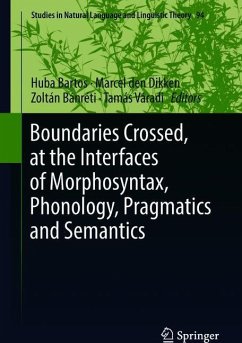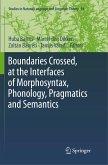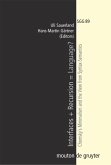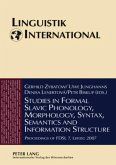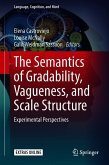Boundaries Crossed, at the Interfaces of Morphosyntax, Phonology, Pragmatics and Semantics
Herausgegeben:Bartos, Huba; Den Dikken, Marcel; Bánréti, Zoltán; Váradi, Tamás
Boundaries Crossed, at the Interfaces of Morphosyntax, Phonology, Pragmatics and Semantics
Herausgegeben:Bartos, Huba; Den Dikken, Marcel; Bánréti, Zoltán; Váradi, Tamás
- Gebundenes Buch
- Merkliste
- Auf die Merkliste
- Bewerten Bewerten
- Teilen
- Produkt teilen
- Produkterinnerung
- Produkterinnerung
This volume offers a selection of interface studies in generative linguistics, a valuable "one-stop shopping" opportunity for readers interested in the ways in which the various modules of linguistic analysis intersect and interact. The boundaries between the lexicon and morphophonology, between morphology and syntax, between morphosyntax and meaning, and between morphosyntax and phonology are all being crossed in this volume. Though its focus is on theoretical approaches, experimental studies are also included. The empirical focus of many of the contributions is on Hungarian, and several…mehr
Andere Kunden interessierten sich auch für
![Boundaries Crossed, at the Interfaces of Morphosyntax, Phonology, Pragmatics and Semantics Boundaries Crossed, at the Interfaces of Morphosyntax, Phonology, Pragmatics and Semantics]() Boundaries Crossed, at the Interfaces of Morphosyntax, Phonology, Pragmatics and Semantics123,99 €
Boundaries Crossed, at the Interfaces of Morphosyntax, Phonology, Pragmatics and Semantics123,99 €![Interfaces + Recursion = Language? Interfaces + Recursion = Language?]() Uli Sauerland / Hans-Martin Gärtner (eds.)Interfaces + Recursion = Language?126,99 €
Uli Sauerland / Hans-Martin Gärtner (eds.)Interfaces + Recursion = Language?126,99 €![Studies in Formal Slavic Phonology, Morphology, Syntax, Semantics and Information Structure Studies in Formal Slavic Phonology, Morphology, Syntax, Semantics and Information Structure]() Studies in Formal Slavic Phonology, Morphology, Syntax, Semantics and Information Structure118,35 €
Studies in Formal Slavic Phonology, Morphology, Syntax, Semantics and Information Structure118,35 €![Discourse Markers Discourse Markers]() Graham RangerDiscourse Markers85,99 €
Graham RangerDiscourse Markers85,99 €![Discourse Markers Discourse Markers]() Graham RangerDiscourse Markers62,99 €
Graham RangerDiscourse Markers62,99 €![The Semantics of Gradability, Vagueness, and Scale Structure The Semantics of Gradability, Vagueness, and Scale Structure]() The Semantics of Gradability, Vagueness, and Scale Structure85,99 €
The Semantics of Gradability, Vagueness, and Scale Structure85,99 €![Beyond Language Boundaries Beyond Language Boundaries]() Beyond Language Boundaries96,99 €
Beyond Language Boundaries96,99 €-
-
-
This volume offers a selection of interface studies in generative linguistics, a valuable "one-stop shopping" opportunity for readers interested in the ways in which the various modules of linguistic analysis intersect and interact. The boundaries between the lexicon and morphophonology, between morphology and syntax, between morphosyntax and meaning, and between morphosyntax and phonology are all being crossed in this volume. Though its focus is on theoretical approaches, experimental studies are also included. The empirical focus of many of the contributions is on Hungarian, and several chapters respond to work published by István Kenesei, to whom the volume is dedicated.
Produktdetails
- Produktdetails
- Studies in Natural Language and Linguistic Theory 94
- Verlag: Springer / Springer International Publishing / Springer, Berlin
- Artikelnr. des Verlages: 978-3-319-90709-3
- 1st ed. 2019
- Seitenzahl: 428
- Erscheinungstermin: 6. Juli 2018
- Englisch
- Abmessung: 241mm x 160mm x 29mm
- Gewicht: 794g
- ISBN-13: 9783319907093
- ISBN-10: 3319907093
- Artikelnr.: 52022617
- Herstellerkennzeichnung Die Herstellerinformationen sind derzeit nicht verfügbar.
- Studies in Natural Language and Linguistic Theory 94
- Verlag: Springer / Springer International Publishing / Springer, Berlin
- Artikelnr. des Verlages: 978-3-319-90709-3
- 1st ed. 2019
- Seitenzahl: 428
- Erscheinungstermin: 6. Juli 2018
- Englisch
- Abmessung: 241mm x 160mm x 29mm
- Gewicht: 794g
- ISBN-13: 9783319907093
- ISBN-10: 3319907093
- Artikelnr.: 52022617
- Herstellerkennzeichnung Die Herstellerinformationen sind derzeit nicht verfügbar.
Marcel den Dikken: Introduction.- Part I: The lexicon and morphophonology.- Zoltán Bánréti: Lexical recursion in aphasia: Case studies.- Ferenc Kiefer & Boglárka Németh: Aspectual constraints on noun incorporation in Hungarian.- Károly Bibok: Instrument-subject alternation from a lexical-pragmatic perspective.- Marianne Bakró-Nagy: Mansi loanword phonology: A historical approach to the typology of repair strategies of Russian loanwords in Mansi.- Robert Vago: The epistemic/deontic suffix -hat/het in Hungarian: Derivational or inflectional?.- Part II: Morphology and syntax.- Katalin É. Kiss: Possessive agreement turned into a derivational suffix.- Veronika Heged s: The rise of the modifier suffix -i with PPs.- Henk van Riemsdijk: Hybrid categories and the CIT.- Marta Ruda: Local operations deriving long-distance relations: Object agreement in Hungarian and the genitive of negation in Polish.- Marcel den Dikken: An integrated perspective on Hungarian nominal andverbal inflection.- Christina Tortora: Evidence for generalized verbal periphrasis in English.- Part III: Morphosyntax and meaning.- Julia Bacskai-Atkari: Marking finiteness and low peripheries.- Beáta Gyuris: Ugye in Hungarian: Towards a unified analysis.- László Kálmán: Neo-Lockean semantics.- Anna Szabolcsi: Strict and non-strict negative concord in Hungarian: A unified analysis.- Balázs Surányi: Focus in focus.- Gábor Alberti & Judit Farkas: The relationship in Hungarian of animacy features to information-structural functions, degrees of referentiality and number.- Krisztina Szécsényi: Control and the left periphery: The scope and information structure properties of Hungarian infinitival clauses with nominative, dative and covert subjects.- Part IV: Morphosyntax and phonology.- Jaklin Kornfilt: Sounds are not equal, nor is all silence.- Michael Brody: Two advantages of precedence syntax.- Anikó Lipták: Dissecting adpositional particle constructions: Remarks from ellipsis.- Tim Mckinnon, Gabriella Hermon, Yanti & Peter Cole: From phonology to syntax: Insights from Jangkat Malay.- Judit Gervain: Gateway to language: The perception of prosody at birth.- Irene Vogel: The morpho-syntax-phonology interface in complex compounds
Marcel den Dikken: Introduction.- Part I: The lexicon and morphophonology.- Zoltán Bánréti: Lexical recursion in aphasia: Case studies.- Ferenc Kiefer & Boglárka Németh: Aspectual constraints on noun incorporation in Hungarian.- Károly Bibok: Instrument-subject alternation from a lexical-pragmatic perspective.- Marianne Bakró-Nagy: Mansi loanword phonology: A historical approach to the typology of repair strategies of Russian loanwords in Mansi.- Robert Vago: The epistemic/deontic suffix -hat/het in Hungarian: Derivational or inflectional?.- Part II: Morphology and syntax.- Katalin É. Kiss: Possessive agreement turned into a derivational suffix.- Veronika Heged s: The rise of the modifier suffix -i with PPs.- Henk van Riemsdijk: Hybrid categories and the CIT.- Marta Ruda: Local operations deriving long-distance relations: Object agreement in Hungarian and the genitive of negation in Polish.- Marcel den Dikken: An integrated perspective on Hungarian nominal andverbal inflection.- Christina Tortora: Evidence for generalized verbal periphrasis in English.- Part III: Morphosyntax and meaning.- Julia Bacskai-Atkari: Marking finiteness and low peripheries.- Beáta Gyuris: Ugye in Hungarian: Towards a unified analysis.- László Kálmán: Neo-Lockean semantics.- Anna Szabolcsi: Strict and non-strict negative concord in Hungarian: A unified analysis.- Balázs Surányi: Focus in focus.- Gábor Alberti & Judit Farkas: The relationship in Hungarian of animacy features to information-structural functions, degrees of referentiality and number.- Krisztina Szécsényi: Control and the left periphery: The scope and information structure properties of Hungarian infinitival clauses with nominative, dative and covert subjects.- Part IV: Morphosyntax and phonology.- Jaklin Kornfilt: Sounds are not equal, nor is all silence.- Michael Brody: Two advantages of precedence syntax.- Anikó Lipták: Dissecting adpositional particle constructions: Remarks from ellipsis.- Tim Mckinnon, Gabriella Hermon, Yanti & Peter Cole: From phonology to syntax: Insights from Jangkat Malay.- Judit Gervain: Gateway to language: The perception of prosody at birth.- Irene Vogel: The morpho-syntax-phonology interface in complex compounds

